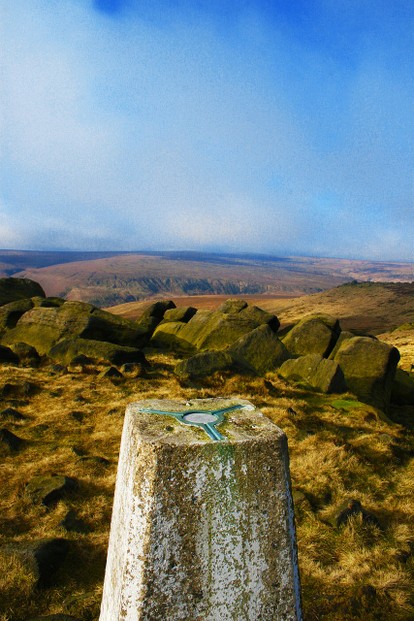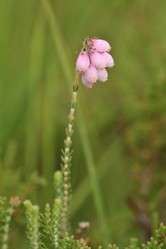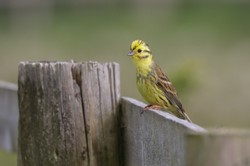Peat does not ignite spontaneously, especially not in its default state of wetness, so it only burns when it is dry. Britain has been suffering/enjoying [depending on your view] a sustained heatwave in which temperatures have soared. This may be connected with general trends in a warming climate, where the north of Britain suffers hot summers, but stormier winters; and this has been a hot summer! The result is that the peat is tinder-dry. A discarded cigarette, a spark from a camp fire or from an inefficient engine would be sufficient to set the fire off. I discount lightning as in Britain it usually occurs with heavy rainfall, which quenches the flames.
Moorland fires can be flash fires, which burn off the tops of dry heather and other moorland plants, often burning so quickly that insects survive; but when the peat burns you get a problem, for the fire can simmer under the surface,moving inexorably along without people noticing, to spring up elsewhere later on when you think it is quenched. This is what has been happening on Saddleworth Moor, where firefighters are finding that flames spring up in unexpected places, even where they have previously been previously extinguished. The best hope for firefighters dealing with a blaze like this is a heavy rain storm, but rain is not due until weekend, in three days' time. In the meantime we must keep the fire away from the residential areas in the towns, but there are sheep farms that need defending and that is going to be difficult. So far no one has been killed or injured, and the damage has been to animal life and property.
Moorland fires are not a new phenomenon, for they have a long history, even the Bronte sisters who dwelt on the moors at Hawsworth, encountered one. Fire is a natural part of the cycle of life on the moor, and it serves to burn off dead heather and provide scope for new shoots, but it is moderated by England's normally rainy climate. But as summers become hotter and drier there is a danger that moorland fires will become harder to control and more damaging. Gamekeepers have in the past and even in the present practised controlled burning of patches so as to provide variety of heather,as the new growth provides food for grouse. The grouse are bred for shooting and are maintained by gamekeepers. There is no evidence that controlled burning started these fires, and indeed no sane, self-respecting and competent gamekeeper or farmer would set off fires in the weather conditions that Britain is now experiencing.
While fire is an ancient phenomenon, on valuable land it damages important projects. We cannot prevent it, all we can do is minimize its occurrence and put it out as soon as possible.








 Women of the Gospelson 10/11/2025
Women of the Gospelson 10/11/2025
 Religious Gardenson 08/25/2025
Religious Gardenson 08/25/2025
 Doctor of the Church: John Henry Newmanon 08/03/2025
Doctor of the Church: John Henry Newmanon 08/03/2025
 Restoring the Palm Houseon 07/16/2025
Restoring the Palm Houseon 07/16/2025




Comments
No.they do not seem to have associations with water, but most,of Britain is wet.
Thank you for the convincing, plausible, undoubtedly correct comment below in answer to my previous, same-day observations and question.
Nothing that I come across in online sources correlates sycamore trees (Platanus spp) with fire-, ice-, wind-exploding trees.
And yet sycamore trees delighted early Unitedstatesian settlers because of their development around water bodies.
Do they have such a reputation among east-side ponders?
They grow in wetn places.so possibly contain water that turns.to steam......
Thank you!
English Wikipedia associates fire-exploding trees with aspen and eucalyptus species. It attributes eucalyptus explosions to what you aver below.
That article does not explain why aspen trees explode.
What might you hypothesize?
I have never heard of the phenomenon of exploding trees, so they cannot be common in the British Isles. Maybe oil in the wood, as eucalyptus has, causes trees to explode in conditions of intense heat.
Thank you for your comment below on Oct. 17, 2019, in answer to my previous-day observations and question Oct. 16, 2019.
Window breakage caused me to consider trees exploding from such events as fires, high winds and ice.
Have there been famous, major exploding trees in the British Isles?
I don't think that window breakage is the major issue. A year after the fire the moor is recovering.
I think that moorland burning needs to be reported to the fire brigade.
frankbeswick, Thank you for the photo, practicalities and products.
Do people have to worry about windows breaking in situations of high winds and stubborn fires? How is the situation a bit over a year later?
You mention that controlled burns appear not to be causing or continuing the moorland fire. On this side of the pond, people need to inform dispatch whenever they burn. Would that be the case on your side of the pond?
While the fire is under control, a new fire has started on a place called Winter Hill; and this time someone has been arrested for arson. Doing this deliberately is disgraceful. Storms are due in Wales and the South West, so they are unlikely to resolve a fire problem in the North West, and it is likely that the the storms will be intense enough to bring localized flooding.
By the time that I had posted my article the number of firefighters had risen to a hundred, and these were assisted by a company of soldiers, a hundred strong. That's the trouble with writing news, it is in constant need of refreshment!
The fact that you saw a programme on moors that showed granite outcrops tells me that you saw Cornish moors, either Bodmin Moor or Dartmoor, in the South West. The bedrock of the area where this fire is taking place is Millstone Grit, a coarse conglomerate that was formed in a delta from the Carboniferous period.
What you say about New Orleans is interesting, especially the bit about air pockets. The fact that in New Orleans they burned for months sounds worrying, but the climate in Fall and Winter in our area is rather wet with much rain, so that will have a dampening effect. We are hopeful for weekend, as storms are coming in, though their epicentre will be Wales, which is not so far away, so we might get some rain to soak the ground. We live in hope.
Sadly, when I worked in a school in the affected region I sometimes used to go out at lunchtime and eat on the moor for a bit of peace and quiet.I don't think that my refuge will have been burned, but the fire is not far away from it.